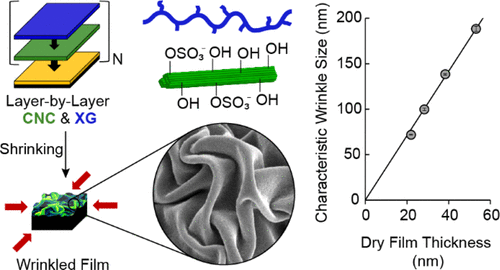当前位置:
X-MOL 学术
›
Biomacromolecules
›
论文详情
Our official English website, www.x-mol.net, welcomes your
feedback! (Note: you will need to create a separate account there.)
Xyloglucan Structure Impacts the Mechanical Properties of Xyloglucan-Cellulose Nanocrystal Layered Films-A Buckling-Based Study.
Biomacromolecules ( IF 5.5 ) Pub Date : 2020-08-17 , DOI: 10.1021/acs.biomac.0c01031 Taylor C Stimpson 1 , Bernard Cathala 2 , Céline Moreau 2 , Jose M Moran-Mirabal 3 , Emily D Cranston 1, 4, 5
Biomacromolecules ( IF 5.5 ) Pub Date : 2020-08-17 , DOI: 10.1021/acs.biomac.0c01031 Taylor C Stimpson 1 , Bernard Cathala 2 , Céline Moreau 2 , Jose M Moran-Mirabal 3 , Emily D Cranston 1, 4, 5
Affiliation

|
Interactions between polysaccharides, specifically between cellulose and hemicelluloses like xyloglucan (XG), govern the mechanical properties of the plant cell wall. This work aims to understand how XG molecular weight (MW) and the removal of saccharide residues impact the elastic modulus of XG–cellulose materials. Layered sub-micrometer-thick films of cellulose nanocrystals (CNCs) and XG were employed to mimic the structure of the plant cell wall and contained either (1) unmodified XG, (2) low MW XG produced by ultrasonication (USXG), or (3) XG with a reduced degree of galactosylation (DGXG). Their mechanical properties were characterized through thermal shrinking-induced buckling. Elastic moduli of 19 ± 2, 27 ± 1, and 75 ± 6 GPa were determined for XG–CNC, USXG–CNC, and DGXG–CNC films, respectively. The conformation of XG adsorbed on CNCs is influenced by MW, which impacts mechanical properties. To a greater degree, partial degalactosylation, which is known to increase XG self-association and binding capacity of XG to cellulose, increases the modulus by fourfold for DGXG–CNC films compared to XG–CNC. Films were also buckled while fully hydrated by using the thermal shrinking method but applying the heat using an autoclave; the results implied that hydrated films are thicker and softer, exhibiting a lower elastic modulus compared to dry films. This work contributes to the understanding of structure–function relationships in the plant cell wall and may aid in the design of tunable biobased materials for applications in biosensing, packaging, drug delivery, and tissue engineering.
中文翻译:

木葡聚糖结构影响木葡聚糖-纤维素纳米晶体层状膜的机械性能-基于屈曲的研究。
多糖之间的相互作用,特别是纤维素和半纤维素(如木葡聚糖)之间的相互作用决定着植物细胞壁的机械性能。这项工作旨在了解XG分子量(MW)和糖残基的去除如何影响XG纤维素材料的弹性模量。纤维素纳米晶体(CNC)和XG的亚微米级分层膜用于模拟植物细胞壁的结构,并包含(1)未经修饰的XG,(2)通过超声(USXG)产生的低分子量XG,或3)具有降低的半乳糖基化度(DGXG)的XG。它们的机械性能通过热收缩引起的屈曲来表征。XG–CNC,USXG–CNC和DGXG–CNC薄膜的弹性模量分别为19±2、27±1和75±6 GPa。吸附在CNC上的XG的构象受MW影响,这会影响机械性能。与DGXG-CNC相比,DGXG-CNC膜的部分脱半乳糖基化在更大程度上提高了XG的自缔合和XG与纤维素的结合能力,从而使模量增加了四倍。使用热收缩法将膜完全水合时也要弯曲,但要用高压釜加热。结果表明,与干膜相比,水合膜更厚,更柔软,弹性模量更低。这项工作有助于理解植物细胞壁中的结构与功能之间的关系,并可能有助于设计可调谐的生物基材料,用于生物传感,包装,药物输送和组织工程。与DGXG-CNC相比,DGXG-CNC膜的部分脱半乳糖基化在更大程度上提高了XG的自缔合和XG与纤维素的结合能力,从而使模量增加了四倍。使用热收缩法将膜完全水合时也要弯曲,但要用高压釜加热。结果表明,与干膜相比,水合膜更厚,更柔软,弹性模量更低。这项工作有助于理解植物细胞壁中的结构与功能之间的关系,并可能有助于设计可调谐的生物基材料,用于生物传感,包装,药物输送和组织工程。与DGXG-CNC相比,DGXG-CNC膜的部分半乳糖基化在更大程度上提高了XG的自缔合和XG与纤维素的结合能力,从而使模量增加了四倍。使用热收缩法,但在使用高压釜加热的同时,还可以在充分水合的同时使薄膜弯曲。结果表明,与干膜相比,水合膜更厚更柔软,显示出更低的弹性模量。这项工作有助于理解植物细胞壁中的结构与功能之间的关系,并可能有助于设计可调谐的生物基材料,用于生物传感,包装,药物输送和组织工程。与XG-CNC相比,DGXG-CNC膜的模量增加了四倍。使用热收缩法,但在使用高压釜加热的同时,还可以在充分水合的同时使薄膜弯曲。结果表明,与干膜相比,水合膜更厚,更柔软,弹性模量更低。这项工作有助于理解植物细胞壁中的结构与功能之间的关系,并可能有助于设计可调谐的生物基材料,用于生物传感,包装,药物输送和组织工程。与XG-CNC相比,DGXG-CNC膜的模量增加了四倍。使用热收缩法将膜完全水合时也要弯曲,但要用高压釜加热。结果表明,与干膜相比,水合膜更厚,更柔软,弹性模量更低。这项工作有助于理解植物细胞壁中的结构与功能之间的关系,并可能有助于设计可调谐的生物基材料,用于生物传感,包装,药物输送和组织工程。
更新日期:2020-09-14
中文翻译:

木葡聚糖结构影响木葡聚糖-纤维素纳米晶体层状膜的机械性能-基于屈曲的研究。
多糖之间的相互作用,特别是纤维素和半纤维素(如木葡聚糖)之间的相互作用决定着植物细胞壁的机械性能。这项工作旨在了解XG分子量(MW)和糖残基的去除如何影响XG纤维素材料的弹性模量。纤维素纳米晶体(CNC)和XG的亚微米级分层膜用于模拟植物细胞壁的结构,并包含(1)未经修饰的XG,(2)通过超声(USXG)产生的低分子量XG,或3)具有降低的半乳糖基化度(DGXG)的XG。它们的机械性能通过热收缩引起的屈曲来表征。XG–CNC,USXG–CNC和DGXG–CNC薄膜的弹性模量分别为19±2、27±1和75±6 GPa。吸附在CNC上的XG的构象受MW影响,这会影响机械性能。与DGXG-CNC相比,DGXG-CNC膜的部分脱半乳糖基化在更大程度上提高了XG的自缔合和XG与纤维素的结合能力,从而使模量增加了四倍。使用热收缩法将膜完全水合时也要弯曲,但要用高压釜加热。结果表明,与干膜相比,水合膜更厚,更柔软,弹性模量更低。这项工作有助于理解植物细胞壁中的结构与功能之间的关系,并可能有助于设计可调谐的生物基材料,用于生物传感,包装,药物输送和组织工程。与DGXG-CNC相比,DGXG-CNC膜的部分脱半乳糖基化在更大程度上提高了XG的自缔合和XG与纤维素的结合能力,从而使模量增加了四倍。使用热收缩法将膜完全水合时也要弯曲,但要用高压釜加热。结果表明,与干膜相比,水合膜更厚,更柔软,弹性模量更低。这项工作有助于理解植物细胞壁中的结构与功能之间的关系,并可能有助于设计可调谐的生物基材料,用于生物传感,包装,药物输送和组织工程。与DGXG-CNC相比,DGXG-CNC膜的部分半乳糖基化在更大程度上提高了XG的自缔合和XG与纤维素的结合能力,从而使模量增加了四倍。使用热收缩法,但在使用高压釜加热的同时,还可以在充分水合的同时使薄膜弯曲。结果表明,与干膜相比,水合膜更厚更柔软,显示出更低的弹性模量。这项工作有助于理解植物细胞壁中的结构与功能之间的关系,并可能有助于设计可调谐的生物基材料,用于生物传感,包装,药物输送和组织工程。与XG-CNC相比,DGXG-CNC膜的模量增加了四倍。使用热收缩法,但在使用高压釜加热的同时,还可以在充分水合的同时使薄膜弯曲。结果表明,与干膜相比,水合膜更厚,更柔软,弹性模量更低。这项工作有助于理解植物细胞壁中的结构与功能之间的关系,并可能有助于设计可调谐的生物基材料,用于生物传感,包装,药物输送和组织工程。与XG-CNC相比,DGXG-CNC膜的模量增加了四倍。使用热收缩法将膜完全水合时也要弯曲,但要用高压釜加热。结果表明,与干膜相比,水合膜更厚,更柔软,弹性模量更低。这项工作有助于理解植物细胞壁中的结构与功能之间的关系,并可能有助于设计可调谐的生物基材料,用于生物传感,包装,药物输送和组织工程。











































 京公网安备 11010802027423号
京公网安备 11010802027423号